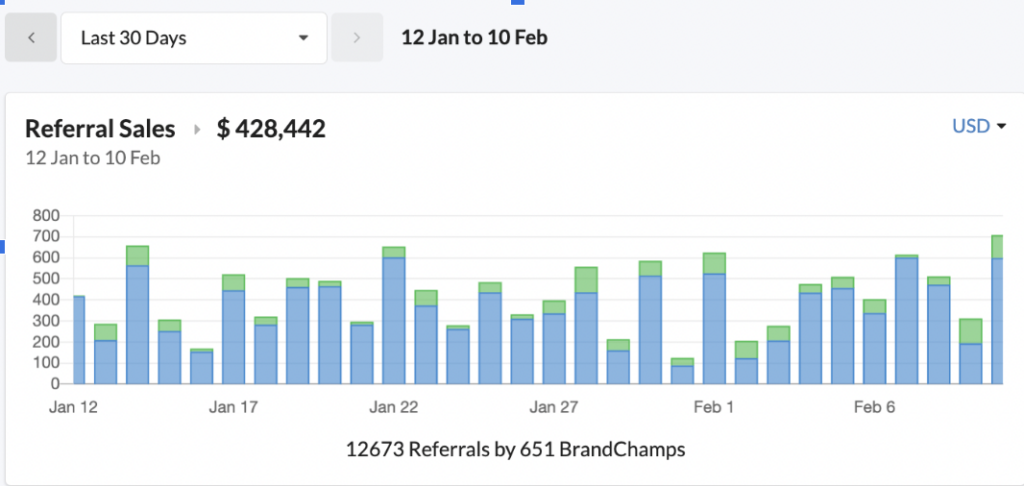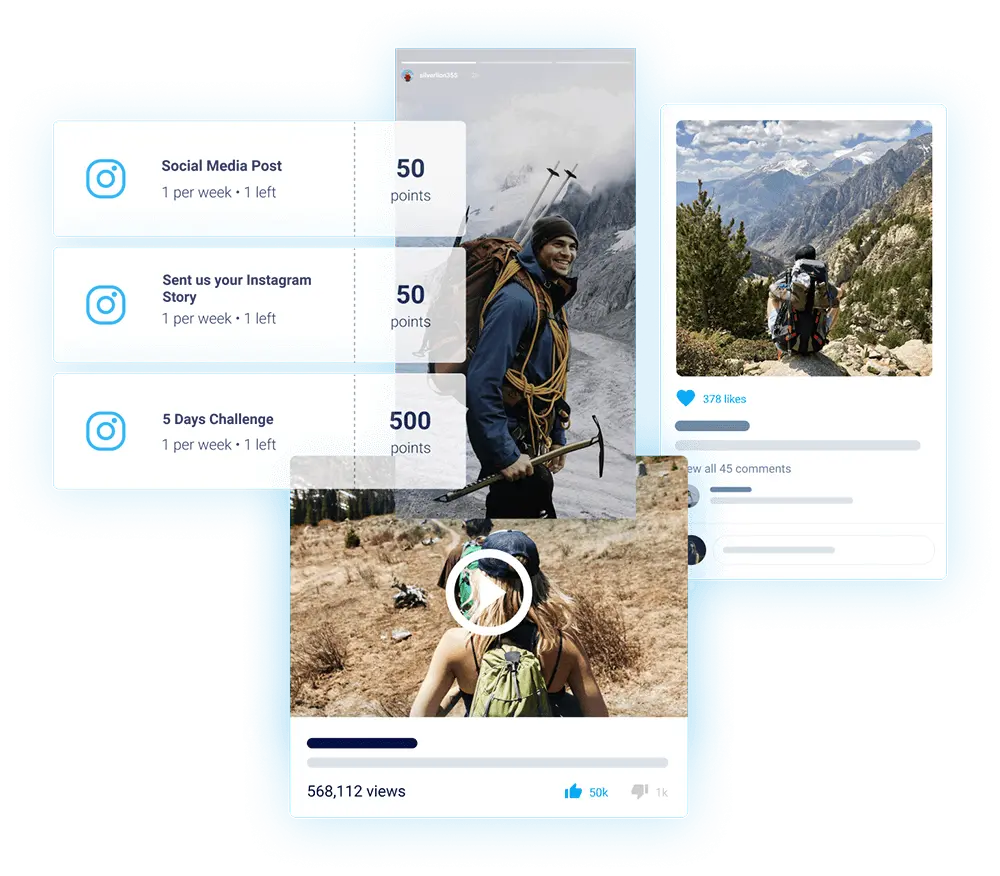76% of all internet users are part of at least one online community – a group, page, event, or forum, where they actively read and share opinions. This means one thing above all for your marketing strategy: people want to belong and participate. In order to create that kind of appeal, and you need to know the intricacies of how to build a community online.

Simply put, an online community is a group of people interacting with each other on an online platform. Its members share common interests, values, or goals. Online relationships provide a sense of friendship, family, and even home. What’s more, almost as many internet users trust information from community sites (42%) as much as traditional news sources (52%).
What does this mean for brands? Among its many other benefits, community building improves brand loyalty, helps gain and retain customers, lowers support costs, and increases revenue. By identifying your most prominent advocates and inviting them to be brand ambassadors, you can build an online community in a way that’s organic and lasting.
How to Build a Community Online – Where to Start?
1. Identify the purpose for your community
The first step when building a community online should be to find and understand your purpose. Are you looking to understand your customers’ needs better? Do you want more organic, user-generated content? Or you could aim to create a safe space for sharing information. The following steps will naturally fall into place when you know what you’re trying to achieve.
With a clear purpose, users will understand why they should join your online community. It would be best if you gave something of value. What kind of experience or information do you want to share with your community? What sort of activity do you want to encourage?
Purposes of community-building:
- To be seen as a leader or expert in your niche
- Increase word-of-mouth marketing
- Get direct feedback from consumers
- Increase brand loyalty and customer retention
- Quickly respond to market shifts
- Increase user-generated content
- Reduce ad spend
- Improve the overall customer experience
2. Setting goals for engagement and growth
All of your goals should be SMART: specific, measurable, achievable, relevant, and time-bound.

It helps if you also determine how progress will be measured. Your key performance indicators (KPIs) will be different depending on the goal you set. KPIs can include:
- The total number of members or users
- New sign-ups
- Referral sales
- Website traffic
- Average order value
- Total engagements – comments, likes, poll answers, UGC posts, etc.
3. Define your target audience and understand their needs
A community-based marketing strategy becomes successful not by focusing on driving sales but by helping people meet their needs. This means that you must perfectly understand your target members and create a space that suits them. Thriving communities inherently belong to their users, not brands.
An Ideal Member will benefit the most from your community, knowledge, and product. They should be valuable for you and the community as a whole. Here are some factors you should consider when trying to narrow down your target audience and Ideal Members:
- Demographic, geographic, and psychographic qualities
- Wealth
- Education
- Stage of life
- Hopes and dreams
- Fears and limitations
If you already have a community, no matter how small or large, don’t hesitate to ask them questions. Some valuable things to ask are the following:
- What are your biggest goals in life right now?
- What are you scared of?
- What do you admire in others?
- What is something that brings you instantaneous joy?
These might not look like questions related to your niche in any way – and they don’t need to be. They’re a way to get to know your community and adjust your content to their needs.
Identifying your ideal community members will make it easier to determine what they’re looking for. This can include: having meaningful relationships, feeling heard and accepted, or finding reliable information.
4. Creating a content strategy
When creating a content strategy, take some time to test out what works and what doesn’t. It’s essential to make sure members feel your presence, but don’t overdo it with unnecessarily frequent posting.
Don’t just focus on sales content. Increasing revenue may be your long-term goal, but that’s different from how you get there. Provide educational and entertaining content to create a community of trust and friendship. Remember, it should be connected to your niche. Adjust the type of information you provide and the form of posts to your company branding and target audience values.
Remember – it’s all about connection. Encourage conversation, ask questions (and answer them!), and make your audience feel heard and involved. Think about how you can best inspire user-generated content. Maybe it’s time to launch a rewards program to encourage more posts.
What is an ambassador marketing program?
Ambassador marketing is a way for brands to market their products or services through their top customers instead of advertising to them. Brand ambassadors usually start as fans – they can be online influencers, content creators, employees, or regular customers.
Their genuine love and passion for the company’s offers allow them to build authentic connections and brand loyalty. An ambassador marketing program often overlaps with an influencer, referral, advocacy, and affiliate marketing.
What is ambassador marketing software?
Brand ambassador marketing software helps you effectively plan, manage and track the performance of your campaigns. A great example is BrandChamp—a platform that provides ambassador marketing programs that drive growth and revenue.

The platform is focused on quality community building. It offers a separate portal for community managers and brand advocates. Both are clear and easy to use.
Members invited to the referral program are offered insight into the ambassador leaderboard, sparking a little friendly competition. Gamification of points and rewards increases engagement and makes the whole experience fun. The platform can be connected with your e-commerce store to make it easier to redeem gifts and discounts.
BrandChamp is a practical, customizable tool. Decide on the activity types, rewards, tiered incentive programs, groups, and even multi-program support you want to offer. You’ll feel entirely in control using it while easily increasing customer lifetime value.
The key features of BrandChamp are:
- Content management
- Ambassador referral sales tracking
- Influencer management
- E-commerce integration
- Social integration
- Customer Success
- Analytics & reporting
- Email marketing
- User management
- Segment and fraud protection
- A separate portal for community managers and brand advocates
This software is the perfect solution to building an online community – and getting the most out of the one you’ve already made. It allows you to track ambassador referrals and automatically issue commissions easily. All the collected data is presented clearly, so you can see which ambassadors are performing the best and monitor the program’s success.

Sign up for a free BrandChamp demo to kick-start your company’s growth.
Tips for identifying and recruiting brand ambassadors
Finding quality brand ambassadors who advocate for your company can be more complicated than it seems. Such a person needs to be:
- Trusted in the community – this is the most sought-after quality amongst followers (47%). What’s interesting, 34% of users consider a smaller follower count (below 10,000) to be the most credible
- Likable
- Knowledgeable
- Representative of your brand values
- Naturally passionate about your niche

Here are some aspects you should consider before you pick exemplary ambassadors who will help you to build an engaged community:
- Examine the quality of content your potential ambassador posts – it’s much more critical than their follower count.
- Only choose ambassadors who post about topics related to your industry. You want to build an online community with people already interested in your niche.
- Look for someone influential – this isn’t necessarily linked to their follower count but rather the trust of those followers.
- Check your potential brand ambassador’s post frequency and engagement rate. The user must be active, but your content might get lost if their feed looks too full. The comments and engagements should feel real – without any bots or spam.
- Check the follower count across platforms. They may have barely 1000 followers on Instagram, but ten times as many on YouTube. Keep in mind the numbers matter less than the engagement. Look into how active those followers are across platforms.
How to engage and manage ambassadors
Effective ambassador marketing can be tricky because you need more control over what is said and posted about your brand. After closely evaluating your potential ambassador’s content, you will know what you can expect from them. Tailor your expectations to match reality.

When talking to your potential ambassador, start by describing in detail what you want from them and what they can expect in return. Clear communication is vital. If you can’t reach an agreement, it might be better to look for someone else or hire a paid influencer.
After you pick out the right people, you must utilize them to their maximum potential. Invest more in your high performers – this can mean frequent free products or any other perks your ambassador might enjoy.
Engaging them in an early testing program is a great way to get more out of your ambassadors. This will make them feel significant and cared for. At the same time, it increases the excitement for your new product and gives you priceless feedback from a caring customer.
BrandChamp helps manage ambassadors effectively with an easy-to-use onboarding system, referral sales tracking, activity management, and personalized rewards. It’s the perfect tool to organize and monitor ambassador participation, analyze their effectiveness, and reward them.
Successful ambassador marketing programs and online community building
Still not sure whether to invest in an ambassador marketing program to kick-start your online community? Take a look at a couple of success stories fuelled by BrandChamp.
SkirtSport – 1000 brand ambassadors and 95,000 photos from online community members
SkirtSports is more than a sports clothes brand – it’s a diverse online community of inspiring women who value an active lifestyle.

BrandChamp helped to organize over 1000 brand ambassadors while linked to the brand’s social media and e-commerce platforms. In just one year, SkirtSports managed to grow its customer base exponentially. Well-managed, rewarded, and happy ambassadors helped create:
- 70,000 Instagram photos
- 25,000 organic social media posts
- 38,000 new Facebook followers
- 95,00 #womenwhomove Instagram photos from the online community.
EHPLabs – a five-fold increase in sales thanks to a well-functioning branded online community
EHPLabs is a fitness-focused supplement brand. They help their customers achieve their fitness, weight loss, and health goals.

Thanks to BrandChamp and its automation possibilities, the company’s community managers could focus on community building instead of wasting time on grunt work with spreadsheets. With new solutions, they could accurately measure growth, track activities and sales, and automate their ambassador rewards program.
With BrandChamp’s automation, streamlining, and management software, EHPLabs increased their monthly referral sales from $6,000 to $30,000+. All this was done without adding any new ambassadors to their online community. Their content engagement is currently at an all-time high.
Utilizing Social Media to Grow Your Online Community
Did you know that almost 50% of internet users use social media to look for and learn about brands? Moreover, GenZ and Millenials trust product reviews from an online community more than from a specialist review. That’s reason enough to utilize this method of marketing.

There are two basic approaches to building an online community:
1. Community platforms
Typically require a login and password and are hosted on your website—more effort, time, and money are necessary to create a safe and engaging space. In return, you’ll offer more valuable ways to interact with and own all of your customers’ data. You’re in total control, so you can limit any distractions or even make access subscription-based.
2. Social platforms
Ready-to-use, free community platforms (Facebook, Instagram, LinkedIn, etc.). They’re usually free, and most of your customers are already actively using them. Facebook groups can be a great place to start, but they have come with some setbacks: restrictions, regulations, limited options, many distractions, and a lack of privacy and security.
Consider your target audience’s demographic – their average age, gender, location, and interests to determine which SM platforms they’re probably most active on. You can also look at your competitors or social media analytics tools to see which platforms are the most popular and drive the most traffic.
A Facebook group is a great place to start. Creating a closed space for sharing thoughts and ideas between like-minded people is easy. You could also consider some less obvious options – for instance, a WhatsApp or Slack group. While Facebook has the most active users (2.9 million), WhatsApp is a favorite amongst internet users (16%).
Strategies for creating engaging content on your community platform

Consider some of our tips for creating the best possible content:
- Tailor your content to your target members’ interests and needs
- Use visuals to make your content more engaging
- Encourage user-generated content by asking questions and starting discussions
- Share your content on relevant SM platforms and online communities to reach a wider audience
- Collaborate with other content creators or influencers in your niche to expand your reach and engage with new audiences
- Use analytics to track the performance of your content and adjust your strategy accordingly
- Be consistent with your posting schedule and connect with your community regularly
- Include social sharing buttons on your website or blog
- Be authentic and helpful
- Create a sense of community by giving back
Influencers – the perfect way to attract new members and increase revenue
61% of consumers trust influencers’ recommendations when buying products or services. Now compare that to the 38% of social media users who rely on branded media content. That’s almost half as much – and reason enough to start investing in ambassadors and influencers to recommend your brand.

Partnering with influencers is one of the best ways to grow online communities. Your chosen internet personality already has the attention of people interested in your niche.
Targeting them is a much faster way to reach your ideal community members and quickly gain more customer loyalty. As it turns out, it’s also a significantly higher ROI than banner ads – 11 times as much.
Analytics – measure success and optimize your online community
You can use tools like Google Analytics, Hootsuite Insights, or Facebook Insights to track the activity on your sites. Set up analytics tracking on your website and all SM platforms you’re using. BrandChamp even lets you track referral sales and personalize reports to fit your unique needs.
Some metrics you should definitely be checking on are:
| METRIC | VALUE |
| likes, shares, comments, and click-through rates | measure how engaged your community is with your content, know which types of content are popular with your audience |
| number of followers, members, or subscribers | measure the growth of your community, see which platforms are driving the most growth, and which strategies attract new members |
| website traffic, bounce rate, and time on site | see which platforms are driving the most valuable traffic |
| lead generation, email sign-ups, or sales | measure how effectively your efforts are driving conversions |
Use this information to continuously improve and optimize your strategies for growing online communities.
Creating a Website That Serves as a Community Platform
Tips for creating a good community website
When building a community online, you must focus on something other than social media. Here are some points to consider when designing your website:
- Make it easy to navigate – an easy-to-use menu will help visitors find all the information they need quickly without getting frustrated in the process
- Use visuals – relevant images and videos will make your website more engaging and appealing
- Optimize for mobile – in 2022, 58.99% of global website traffic was generated from mobile devices
- Use clear and concise language that matches your brand
- Provide clear calls to action to guide visitors – these can be “Sign up” or “Learn more”
- Optimize the website load time
- Make sure your site is accessible to all users, including those with disabilities
- Use social proof – include customer testimonials, reviews, and social media links to build trust and credibility
- Be authentic in your interactions with visitors while keeping everything in line with your brand values
- Make it easy to contact you – include a contact page with a clear form or contact details, so it’s easy for visitors to get in touch.
How to run a blog that aligns with your brand community and values
Match your company values with the needs and interests of your online community. Competitors’ websites and user activity are the two best ways to determine what questions your community members want to be answered. Research your audience’s pain points, interests, and needs. Tailor your content to address these issues and provide real value.
Next, set up a content calendar. Plan out your content in advance, so you know when and what to do. Test out the best frequency for you. Remember – quality always comes before quantity. When you’re consistent, you’ll naturally build trust, loyalty, and interest.
Use images and videos to make your information more visually appealing. At the same time, optimize your content for SEO to increase visibility and reach a wider audience. Include brand keywords and link building.
Feel free to collaborate with other bloggers or influencers in your niche to grow your reach and engage with new audiences. This can be a great way to grow your online community naturally.
Last but certainly not least – use analytics to track the performance of your blog. The insights you gain should serve as a way to optimize your strategy.
User-generated content helps improve your brand community
How to build a community online through your website?
- Include space for user-generated content. You can create your own forum or discussion board where members are able to share their thoughts, ideas, and experiences.
- Feature honest customer reviews or testimonials on your site, making your customers feel heard and important. Make it easy for users to share their thoughts and opinions by including social sharing buttons on your website.
- You can also encourage user activity by conducting polls or surveys or hosting a contest or challenge on social media.
Building a sense of an online community on your website also requires fostering relationships among users and encouraging them to connect with other members. You can’t force this, but it’s possible to encourage it. This can be done by creating networking opportunities, recognizing and rewarding the most active members, or providing valuable resources and information.
Other Tips and Strategies for Online Community Building
Hosting events and webinars
Events and webinars effectively build personal and meaningful relationships, provide valuable information and establish the company as more credible. It also encourages engagement, builds loyalty, expands reach, and generates leads.
Building a referral program
A referral program is a powerful way of leveraging the power of word-of-mouth marketing. They encourage existing users to invite their friends and family members to join the community, which can increase new members and engagement.

Offering rewards or incentives for successful referrals encourages users to participate. This increases reach and helps to create a sense of community among members as they can share their experiences and rewards together.
Utilizing email marketing
Email marketing is a direct and personal way to communicate with your brand’s community members and keep them informed. Regular newsletters are a great way to inform about upcoming events and activities, while promotional emails can encourage participation in new initiatives.
Leveraging user-generated content
You may already have an active community surrounding your brand. There are many companies in your position, but only some which actually fully leverage this powerful possibility for growth. Need help with how to use your UGC and ambassadors to their full potential? BrandChamp is the perfect tool for you.

The all-in-one brand ambassador management software is a system that helps build successful communities. The system is easy to use and profitable for both you and your customers looking for reward options. BrandChamp is great for accountability, management, success tracking, and growth.
Conclusion
The ability to create genuine relationships between brands and their customers is a powerful tool for building a successful marketing campaign. A well-run community serves both parties. To your users, it provides valuable information and a sense of belonging – not to mention attractive rewards. For you, it’s the possibility to reach your business goals – faster and more efficiently than ever.
An online community is a perfect way to build company awareness and brand loyalty. If you want to know how to build a community online, first focus on your goal and purpose. Then understand your target audience members and create content that matches their needs. It’s also important to allow group members to interact with each other and to encourage user-generated content.
Sign up for a free demo with BrandChamp to grow your company with sophisticated ambassador marketing software.
FAQ
How do you build an engaged online community?
This requires clearly defining the purpose of the community, encouraging active participation, fostering relationships, rewarding engagement, consistent posting, being transparent and authentic, listening and acting on feedback, being helpful and resourceful, and creating a sense of community by giving back.
What makes successful online communities?
A successful online community has a clear sense of purpose, active engagement, a sense of belonging, strong relationships, quality content, consistent engagement, transparency and authenticity, and responsiveness to feedback. This helps build a brand community full of trust, which leads to regular customers, recommendations, and growth in revenue.













